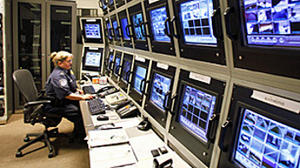Border securityNorthern border "more significant threat" to U.S. security than the Mexican border
As security along the U.S.-Mexico border tightens, drug smugglers and other criminals are shifting their activities to the U.S. northern border; Alan Bersin, head of the U.S. Customs and Border Protection (CBP), told a U.S. Senate subcommittee hearing that the U.S. border with Canada sees far fewer detentions and arrests every year — there are about 445,000 arrests and detentions along the U.S.-Mexico border annually, while last year the U.S.-Canada border saw only 6,000 arrests and detentions — but is a “more significant threat” to American security than the Mexican border; the latest step in cross-border policing will see Canada send twenty-two radar feeds to CBP’s center in California that tracks non-commercial aircraft, with the goal of cracking down on narcotics smuggling by small planes flying low over the border to escape detection; the United States was also moving to deploy “military grade” radar along the northern U.S. border as soon as this fall

CBP will soon be receiving twenty-two radar feeds from Canada // Source: cbc.ca
The U.S. border with Canada sees far fewer detentions and arrests every year, but is a “more significant threat” to American security than the Mexican border, a senior DHS official said Tuesday.
“In terms of the terrorist threat, it’s commonly accepted that [it’s] the more significant threat, because of… people who can enter Canada and then come across our bridges into the United States,” Alan Bersin, head of the U.S. Customs and Border Protection (CBP), told a U.S. Senate subcommittee hearing in Washington.
Bersin was responding to questioning from Senator John Cornyn, a Texas Republican who demanded to know why the southern U.S. border, with about 445,000 arrests and detentions annually, is not considered far more sensitive than the northern boundary, which saw 6,000 arrests and detentions last year.
Bersin said the United States has to “maintain a very high security profile” on the Canadian frontier, in part because Canada and the United States do not share their no-fly lists and so canot keep out people deemed security threats who might travel by airplane into one country, then cross the border by land.
CBC reports that U.S. politicians and officials have often expressed alarm about the U.S. northern border – some because of the false belief that some of the nineteen men who hijacked four airplanes on 9/11 entered the United States from Canada. In February, several lawmakers decried the findings of a GAO report that determined that less than 1 percent of the U.S.-Canada border had reached an “acceptable level of security.”
AP reports that Canada is a significant – and growing — source of high-quality marijuana and the amphetamine Ecstasy. More than two million doses of Ecstasy were seized on the northern border in 2009 compared to just 312,000 in 2004, according to the U.S. Drug Enforcement Administration.
The Toronto Sun reports that unprotected small Canadian airports are being used more and more by the Mexican drug cartels as jump points into the United States.
Senators at Tuesday’s hearing thus asked what efforts are afoot to stem drug smuggling between Canada and the United States.
The Customs and Border Protection chief replied that the latest step in cross-border policing will see Canada send twenty-two radar feeds to his agency’s centre in California that tracks non-commercial aircraft, with the goal of cracking down on narcotics smuggling by small planes flying low over the border to escape detection (see this Canadian Press report).
Missoula, Montana 8KPAX reports that Bersin announced on Tuesday that the United States was moving to deploy “military grade” radar along the northern U.S. border as soon as this fall in an effort to catch low-flying aircraft smuggling drugs from Canada.
Bersin also said U.S. officials are working with the Canada Border Services Agency to permit pre-trip immigration clearance for train travelers from Montreal to New York.
Senators Charles Schumer of New York and Patrick Leahy of Vermont, both Democrats whose states see significant tourism from Canada, had expressed frustration at delays on the Montreal to New York City line, with customs and immigration checks at the border stalling trains by up to two hours on their way south.
“Can we count on you to speed up the trains between Canada and New York?” Schumer asked.
Bersin said one complication on rail company Amtrak’s route is that it stops south of Montreal before hitting the border, making it difficult properly to pre-clear all passengers. His agency already does pre-screening at Vancouver’s train station for Seattle-bound trips, but those trains do not stop elsewhere in B.C.’s Lower Mainland before crossing into Washington state.
